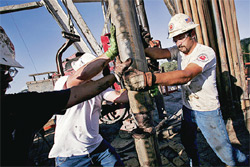The great potential of unconventional
on
The great potential of unconventional
What a difference a mere three years can make. At the Amsterdam World Gas Conference (WGC) in 2006, the conventional wisdom was that US gas production would remain flat, that imports from Canada would continue to fall, and that there would be a boom in LNG imports. The incredible rise of unconventional gas – from shale, tight sands and coal-bed methane (CBM) – has shattered these assumptions. Thanks to new technologies such as horizontal drilling and hydraulic fracturing, the US now appears to have so much economically recoverable gas that it may eventually become a net LNG exporter.
 |
| Workers drill for natural gas in Texas, US |
| Article Highlights: |
| - The recent successful development of “unconventional” gas reserves, as demonstrated in the US, may lead to at least a doubling of current proved worldwide gas reserves. |
| - This gas can be developed at many locations in the world at affordable prices and will undermine the dominant position of Russia in the global energy market. |
| - The Russians dispute the potential of “unconventional” gas, but western companies like BP have no doubts whatsoever. |
Hayward added that he believes ‘there is the potential to find and develop tight gas and shale gas in North Africa and the Middle East, Europe, China and in the southern cone of Latin America’ as well. ‘There's also potentially high quality CBM in Australia and south-east Asia.’ BP estimates that as-yet-undeveloped or unidentified unconventional gas could contribute 4,000 tcf (trillion cubic feet) or 113 tcm (trillion cubic metres) to gas resources over just the next few years. To put this in perspective: Russia’s proved reserves are only 43 tcm.
Daniel Yergin, chairman of Cera, described Hayward’s numbers as a conservative estimate: ‘In the analysis that we’ve done over the last year, the low end of the range is where Tony Hayward put it in his remarks, around 4,000 Tcf. The high end of the range is around 16,000 tcf (453 tcm), which would be double current (global) proved reserves. These are estimates of potential and are far from being established. But they give some sense of the possibilities. It’s happened very quickly.’ So quickly, in fact, that Yergin believes it could take three to four years for the energy industry to get its head around the full implications, not least the regulatory issues.
Not everyone is convinced. Sceptics tend to focus on the high decline rates of the wells being drilled in the Barnett Shale, and more recently in the Haynesville Shale in Louisiana, and are questioning the economics. Perhaps not surprisingly, some gas producers outside North America have been cautioning against too much optimism over the potential for unconventional gas. At the WGC, for example, Alexander Medvedev, the head of Gazprom’s export division, said: ‘There are many myths about shale production.’ He cited the need for continuous drilling to prevent output decline and the environmental issues associated with shale gas production, including the heavy requirement for process water.
Asked to respond to Medvedev’s comments, Hayward was surprisingly blunt: ‘Our view is founded on hard facts and reality. BP is the largest producer of gas in the United States. It has a very significant unconventional gas portfolio in the US, which includes coal-bed methane, tight sandstone reservoirs and a significant shale gas portfolio. We have seen a quite extraordinary revolution in terms of the resource which can be made commercially viable at prices that are very modest as a consequence of the application of technology. It’s primarily drilling technology, fracking [hydraulic fracturing] technology and in some cases seismic imaging technology. And we have begun to take that technology from the US and to deploy it in other parts of the world.’
| A quiet revolution has occurred in the gas fields of North America |
Others are even more optimistic. Dr. Richard Newell, administrator of the US Energy Information Administration, said in Buenos Aires that a lot of unconventional gas would be economic to produce ‘at $5/Mcf or less’. As of early December, that is about equal to spot market prices in the US. The latest World Energy Outlook from the International Energy Agency, published this month, says: ‘Our analysis shows that new unconventional sources of supply have the potential to increase overall North American production at a wellhead cost of between $3/MMBtu and $5/MMBtu [$1/Mcf is roughly equal to $1/MMBtu] for the coming several decades, though rising material costs and rig rates are expected to exert upward pressure on unit costs over time. The high decline rates of unconventional gas will also require constant drilling and completion of new wells to maintain output.’
Oil price linkage under pressure
The wide divergence between the prices of crude oil and traded gas – caused by a collision of recession-battered demand with what the International Energy Agency has described as an ‘acute gas glut’ – is putting pressure on one of the very foundations of the industry: the traditional oil-indexed, long-term take-or-pay contract.
| One field has almost single-handedly turned around the production of natural gas in the US |
The debate over the desirability of indexing gas prices to oil prices in long-term contracts has been going on for decades. Now, however, the conjunction of circumstances referred to by Brufau seems to have won many converts to the idea that it may no longer be the best option. It is certainly unusual for the chief executive of a major LNG player to state the case so definitively in a public forum.


Discussion (0 comments)